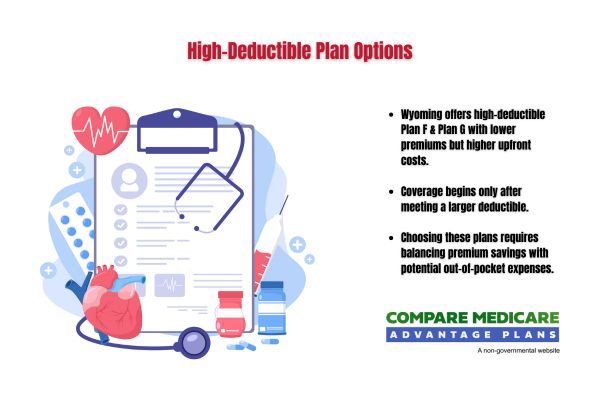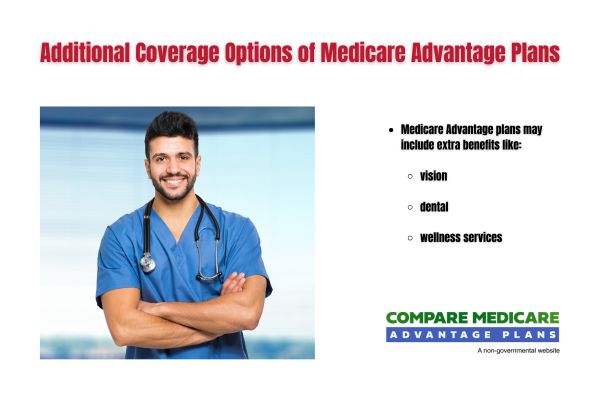




Medicare Supplement Plans Wyoming 2026
Curious about Medicare Supplement Plans in Wyoming
Key Takeaways
- Medicare Supplement (Medigap) Plans will likely help cover costs not included in Original Medicare, such as copayments and deductibles, possibly providing financial predictability for beneficiaries.
- In Wyoming, various standardized Medigap plans (A through N) may be available
in 2026 , likely allowing residents to choose coverage that aligns with their health needs and financial situation.
- The Initial Enrollment Period for Medigap plans will likely offer coverage without medical underwriting, making it the optimal time for beneficiaries to enroll.
Compare Plans in One Step!
Enter Zip Code
Understanding Medicare Supplement Plans

Medicare Supplement Insurance, commonly referred to as Medigap, will likely play a crucial role in enhancing the financial security of Medicare beneficiaries. These plans have been designed to help cover costs not included in Original Medicare, such as copayments, coinsurance, and deductibles. These plans could potentially provide beneficiaries with greater financial predictability and peace of mind by helping to cover these gaps.
Medigap plans will likely be standardized, meaning that each plan type offers the same level of coverage regardless of the insurance provider. This standardization might make it easier for beneficiaries to compare plans and choose the one that best suits their needs. Whether you’re looking for basic coverage or more comprehensive benefits, understanding the nuances of Medigap plans is essential for making informed healthcare decisions.
In Wyoming, residents may choose from a variety of standardized Medigap plans labeled A through N. Each plan will likely offer a distinct combination of benefits, which may allow individuals to select the coverage that aligns with their health needs and financial situation. Here’s a closer look at what Medigap plans might entail and the standardized benefits they provide.
What Are Medigap Plans?
Medigap plans, also known as a Medicare supplement plan, are health insurance policies designed to help cover gaps in Medicare, likely providing additional coverage for beneficiaries. These plans will likely help pay for certain out-of-pocket costs that Original Medicare does not cover, such as copayments, coinsurance, and deductibles. For instance, Medicare Plan F might offer comprehensive coverage for out-of-pocket expenses, while Plan G may be slightly less expensive but could cover everything except the Part B deductible.
Each Medigap plan will likely offer a unique combination of coverage for hospital coinsurance, copayments, and deductibles, with Plans A and B generally providing basic benefits. This could make Medigap plans particularly valuable for beneficiaries who face high coinsurance and hospital costs.
Selecting the appropriate Medigap plan will likely involve assessing personal health requirements, understanding the possible benefits of each plan, and evaluating the reputations of different insurance providers. Carefully considering these factors could help beneficiaries select a plan that offers appropriate coverage and financial protection.
Standardized Benefits of Medigap Plans
One of the possible features of Medigap plans might be that their benefits will likely be standardized across different insurance companies. This means that each plan type (e.g., Plan A, Plan B, etc.) may offer the same level of coverage regardless of the provider. For example, Plan G from one insurer could offer the same benefits as Plan G from another insurer, likely making it easier for beneficiaries to compare plans based on their premiums and services.
Standardization may enable beneficiaries to easily compare Medigap plans based on their offered benefits and premiums. This consistency could be particularly beneficial for those who want to ensure they are getting the best value for their money. Wyoming residents will likely have access to various standardized Medigap plans
- A
- B
- C
- D
- F
- G
- K
- L
- M
- N
Understanding the standardized benefits of Medigap plans may enable beneficiaries to make better-informed decisions about their healthcare coverage. This knowledge could help them select a plan that not only meets their health needs but also fits within their financial constraints.
Medicare Supplement Plans Available in Wyoming for 2026
For residents of Wyoming, there will likely be several Medigap plans available
Each of these plans could offer a distinct combination of benefits, likely allowing individuals to select the coverage that best meets their needs and budget. Understanding the details of each Medigap plan is crucial for beneficiaries to make informed decisions regarding their healthcare coverage.
For those looking to potentially save on premiums, high-deductible versions of Plan F and Plan G may also be available. These options could potentially lead to lower monthly premiums, but beneficiaries might need to meet a higher annual deductible before coverage begins.
Plan A, B, C, D, F, G, K, L, M, and N
In Wyoming, residents will likely have access to a variety of Medigap plans
- Plan A
- Plan B
- Plan C
- Plan D
- Plan F
- Plan G
- Plan K
- Plan L
- Plan M
- Plan N
Each of these plans could offer standardized benefits, possibly ensuring consistent coverage across different insurance providers. This standardization might make it easier for beneficiaries to compare plans and choose the one that best meets their needs.
Each Medigap plan will likely differ in the coverage it offers, such as varying levels of coinsurance, hospital costs, and out-of-pocket expenses. For example:
- Plan A provides basic benefits.
- Plan F may offer the most comprehensive coverage, such as deductibles and coinsurance.
- Plan G might cover everything except the Part B deductible, likely making it a popular choice for those looking for robust coverage at a slightly lower premium.
Understanding the unique benefits and cost-sharing features of each plan is essential for making an informed decision. Comparing the standardized benefits of each plan could help beneficiaries choose the coverage that matches their health needs and financial situation.
High-Deductible Plan Options

For those looking to save on premiums, high-deductible versions of Plan F and Plan G may be available in Wyoming. These plans could potentially allow beneficiaries to enjoy lower monthly premiums, but they might come with higher out-of-pocket costs before coverage kicks in. Beneficiaries must meet a higher deductible before they can access their coverage, likely making it a trade-off between lower premiums and higher upfront costs.
It’s crucial for beneficiaries to understand the possible implications of meeting a higher deductible before selecting a high-deductible option. Considering both the potential premium savings and higher out-of-pocket costs may help beneficiaries decide if a high-deductible plan suits their healthcare needs and financial situation.
Eligibility and Enrollment for Medicare Supplement Plans in Wyoming
To obtain a Medigap policy, individuals must first enroll in Original Medicare, which includes both Medicare Parts A and Part B. Knowing the eligibility criteria and enrollment periods ensures timely and hassle-free enrollment in a Medigap plan.
Initial Enrollment Period
The Initial Enrollment Period for Medigap plans lasts six months, beginning the month a person turns 65 and enrolls in Medicare Part B. This period is the best time to enroll in a Medigap plan because:
- Beneficiaries will not be denied coverage based on their health status.
- Beneficiaries likely won’t be charged higher premiums based on their health status.
Enrolling during the Initial Enrollment Period ensures that beneficiaries have access to the coverage they need without worrying about medical underwriting. This period is a critical window for securing comprehensive healthcare coverage.
Special Enrollment Periods

Special Enrollment Periods allow individuals to enroll in Medigap plans under specific circumstances without medical underwriting. Certain life events, such as losing other health coverage or moving out of a plan’s service area, can trigger a Special Enrollment Period for Medigap plans. In Wyoming, residents will likely have guaranteed issue rights that permit them to enroll in Medigap plans without medical underwriting when they lose coverage from a Medicare Advantage plan.
Understanding these Special Enrollment Periods and guaranteed issue rights will likely be essential for ensuring access to necessary Medigap coverage. Beneficiaries should be aware of the circumstances that qualify for a Special Enrollment Period to avoid gaps in their healthcare coverage.
Guaranteed Issue Rights
Guaranteed issue rights ensure that residents in Wyoming may obtain Medigap plans regardless of their health status during specified enrollment periods. These rights apply when individuals are eligible for Medigap plans, allowing them to enroll without denial due to pre-existing conditions. This means that residents might not face exclusions or higher premiums based on their health when they apply for Medigap coverage.
Understanding guaranteed issue rights is crucial for beneficiaries, as it could provide a safety net during transitions in coverage. Whether it’s losing a Medicare Advantage plan or other qualifying events, these rights could potentially ensure that beneficiaries regain access to continuous and comprehensive healthcare coverage.
Possible Costs Associated with Medicare Supplement Plans in Wyoming
Medigap plans will likely assist in covering out-of-pocket expenses from Original Medicare, possibly ensuring beneficiaries are protected against significant medical costs. Understanding the potential costs associated with these plans, such as premiums and out-of-pocket spending limits, will likely be essential for making an informed decision.
Monthly Premiums
Monthly premiums for Medigap plans might be influenced by various factors such as:
- Age
- Location
- Specific benefits covered by the plan.
- Insurance provider
When selecting a Medigap plan, members should weigh the potential cost of monthly premiums against potential out-of-pocket expenses. This balance could help ensure that the selected plan is both affordable and comprehensive in coverage.
Out-of-Pocket Spending Limits
Certain Medigap plans might have out-of-pocket spending limits that could help protect beneficiaries from excessive medical expenses. These spending limits could potentially reduce the financial burden for beneficiaries facing high medical costs. By capping the amount a beneficiary might have to pay out of pocket, some of these plans could provide a valuable safety net.
Understanding the out-of-pocket spending limits of a Medigap plan is crucial for beneficiaries who anticipate high medical expenses. These limits could offer financial protection and peace of mind, possibly ensuring that healthcare costs remain manageable.
Comparing Costs Across Providers
When comparing costs among different insurance providers, members should consider both premiums and the coverage provided. Premiums may vary widely even for the same coverage, likely making it crucial to compare plans across different insurers.
Utilizing the Plan Finder Tool on this website can provide valuable insights into the possible costs and benefits of different Medigap plans. By assessing premiums, potential benefits, and insurer ratings, beneficiaries can identify the most cost-effective Medigap plan for their needs.
How to Choose the Right Medigap Plan in Wyoming

Choosing the right Medigap plan will likely involve considering personal health conditions and future medical needs. This section will guide readers on how to select the most suitable plan based on their health needs and budget.
Assessing Your Health Needs
Evaluating existing medical conditions and treatment requirements, including chronic conditions, will likely be crucial for determining the necessary coverage level. It’s important to consider current health conditions and anticipated medical needs when evaluating Medigap options. For example, high-deductible plans may be particularly beneficial for those who are healthy and do not expect frequent medical visits, as they could potentially offer long-term savings.
By carefully assessing health needs, beneficiaries should select a plan that provides adequate coverage for their medical requirements. This could potentially ensure that they have the necessary financial protection in place for future healthcare expenses.
Budget Considerations
When selecting a Medigap plan, members should also consider costs, such as monthly premiums and potential out-of-pocket costs. Beneficiaries opting for high-deductible plans may benefit from lower monthly premiums, likely making it an appealing choice for those who are healthy and anticipate fewer medical expenses. Plans K and L, structured with various cost-sharing features, might make them a better option for those who anticipate lower healthcare usage.
Understanding the balance between premiums and out-of-pocket costs is crucial for beneficiaries to select a plan that fits their financial situation. This balance could help to ensure that the chosen plan is both affordable and comprehensive in coverage.
Using Online Resources
Online tools such as the Plan Finder Tool can provide valuable insights into various Medigap plans available in Wyoming. These resources allow individuals to compare costs, coverage options, and provider networks for Medigap plans easily on the site. Just enter your zip code into the Plan Finder Tool on this website.
Leveraging this tool helps beneficiaries make informed decisions and select the best plan for their assistance needs.
Additional Coverage Options: Medicare Advantage Plans

Some Medicare Advantage plans may come with additional benefits that might extend beyond standard Medicare coverage, such as vision, dental, and hearing services. These plans could be an attractive alternative to Medigap plans for some beneficiaries.
Prescription Drug Coverage
Certain Medicare Advantage plans may also offer integrated prescription drug coverage, which may be at a lower cost than standalone Medicare Part D plan. Some Medicare Advantage plans may provide integrated prescription drug coverage, known as MA-PD plans, possibly allowing beneficiaries to receive both medical and drug coverage from a single plan. This potential integration could simplify the management of healthcare benefits and possibly reduce overall costs for beneficiaries through prescription drug plans.
Possible Network Restrictions and Flexibility
Medigap plans will likely allow beneficiaries to see any provider that accepts Medicare, offering greater freedom in provider choice. In contrast, Medicare Advantage plans may require members to use a network of providers, which may limit flexibility in choosing healthcare providers. The potential network restrictions in Medicare Advantage plans might limit provider choices compared to the flexibility of Medigap plans.
Some Medicare Advantage plans may also offer more flexibility in provider choice, such as out-of-network options, which may be at a higher cost.
Protecting Yourself from Medicare Fraud
Protecting yourself from Medicare fraud is crucial for ensuring your personal information and healthcare benefits remain secure.
Guarding Your Medicare Card
Keep your Medicare card and Social Security number private for security reasons by following these recommendations:
- Share them only with trusted healthcare providers.
- Keep your Medicare card in a secure place.
- Avoid carrying your Medicare card in your wallet to reduce the risk of loss or theft.
By keeping your Medicare card private and using it only when necessary, such as during visits with healthcare professionals, you can protect yourself from potential fraud.
Recognizing Fraudulent Activities
Medicare fraud typically involves billing for services not rendered, falsifying claims, or providing unnecessary medical services. Common red flags of Medicare fraud might include receiving services you did not request or unexpected bills for services not received.
If you suspect Medicare fraud, contact the fraud hotline or your Medicare carrier to report your concerns.
Summary
Understanding Medicare Supplement Plans (Medigap) will likely be crucial for managing healthcare costs and ensuring comprehensive coverage. These plans may help cover some out-of-pocket expenses not included in Original Medicare, possibly providing financial predictability and peace of mind for beneficiaries. By exploring the different Medigap plans available in Wyoming
Choosing the right Medigap plan will likely involve assessing personal health needs, evaluating budget considerations, and leveraging this website. Additionally, some Medicare Advantage plans might offer an alternative with integrated prescription drug coverage and additional benefits. Protecting yourself from Medicare fraud is also essential for maintaining the security of your healthcare benefits. By taking charge of your healthcare decisions, you could ensure that you have the necessary coverage to meet your needs
Frequently Asked Questions
→ What are Medicare Supplement Plans (Medigap)?
Medicare Supplement Plans, or Medigap, are specifically designed to fill the coverage gaps in Medicare, likely helping to cover some out-of-pocket expenses like copayments, coinsurance, and deductibles. These plans could potentially enhance your financial protection and possibly ensure more comprehensive healthcare access.
→ When is the best time to enroll in a Medigap plan?
The best time to enroll in a Medigap plan is during the Initial Enrollment Period, which starts the month you turn 65 and enroll in Medicare Part B. Taking action during this window ensures you receive the full benefits available without facing penalties or restrictions.
→ What are high-deductible Medigap plans?
High-deductible Medigap plans, like the high-deductible versions of Plan F and G, could potentially provide lower monthly premiums but might necessitate higher out-of-pocket expenses before coverage kicks in. This could be beneficial if you’re looking to save on monthly costs while managing potential healthcare expenses.
→ How do I compare costs across different Medigap plans?
To effectively compare costs across different Medigap plans, assess both premiums and coverage options from various insurance providers. Utilizing the Plan Finder Tool on this website can help tailor your evaluation to your specific health needs and budget.
→ What should I do if I suspect Medicare fraud?
If you suspect Medicare fraud, it’s crucial to report your concerns immediately by contacting the fraud hotline or your Medicare carrier. Look for signs like receiving unexpected bills or services you did not request.

ZRN Health & Financial Services, LLC, a Texas limited liability company



